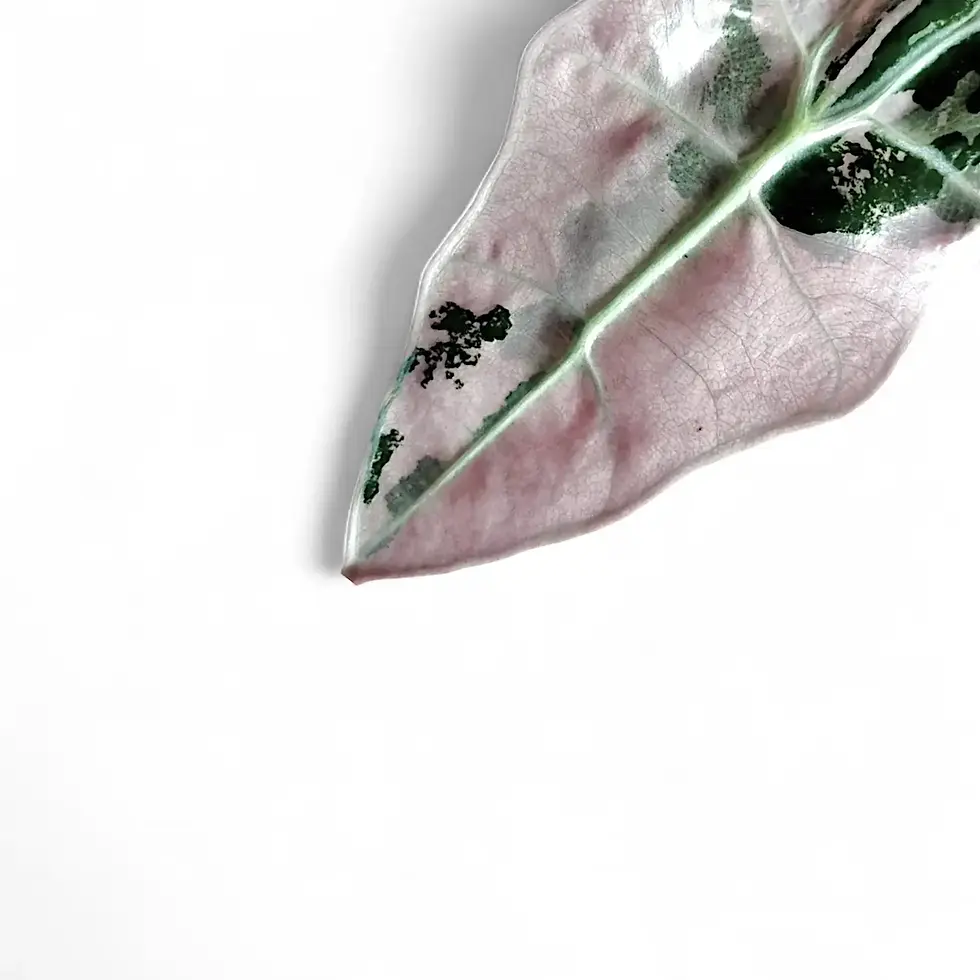Alocasia 'Polly' Albo/Pink-Variegata – Compact Hybrid with White and Blush-Pink Marbling
Alocasia Polly Albo Variegata is one of the most captivating variegated hybrids in the Alocasia × amazonica group. Originating from variegated tissue-culture stock of Alocasia Polly Albo Variegata discovered at Silver Krome Gardens (Florida, USA), it shows unpredictable marbling in white, cream, and soft pink. The pale and pink sectors contain less chlorophyll, so each new leaf of Alocasia Polly Albo Variegata reveals a shifting balance of pigment and pattern. Collectors value this plant for its glossy texture, compact structure, and elegant contrast that fits perfectly into modern indoor design.
● Origin and Genetic Background of Alocasia Polly Albo Variegata
- Parentage: Hybrid of Alocasia sanderiana × Alocasia longiloba ‘Watsoniana’, the same cross that produced Alocasia Amazonica.
- Mutation origin: Variegated sport from tissue-cultured Alocasia Polly lines, later stabilised and released as Alocasia Polly Albo Variegata.
- Colour formation: Pink shades result from anthocyanin pigments over pale tissue; white areas develop where chlorophyll is absent.
- Growth form: Compact, upright habit reaching 30–60 cm, ideal for small interiors or grouped aroid collections.
● Distinctive Traits of Alocasia Polly Albo Variegata
- Leaf shape: Deeply lobed, arrowhead leaves with pronounced scalloping and crisp white veins.
- Variegation: Random marbling and streaking in white and blush-pink—each leaf of Alocasia Polly Albo Variegata is unique.
- Texture: Slightly leathery surface that reflects light like satin, enhancing colour contrast.
- Display value: Perfect statement piece for bright living spaces or curated aroid displays.
● How to Care for Alocasia Polly Albo Variegata Indoors
Light
- Give Alocasia Polly Albo Variegata bright, indirect light to maintain pink and white tones; avoid harsh midday rays.
- Find the right placement with our window-orientation guide.
Watering
- Water when the top 10–15 % of the substrate dries; then drain completely.
- Compact pots and aerated mix prevent root rot in Alocasia Polly Albo Variegata.
- Use rain or filtered water to avoid mineral buildup on variegated tissue.
Humidity and Temperature
- Keep humidity around 60 % RH for crisp edges and vibrant pink tones.
- Maintain 18–26 °C; shield Alocasia Polly Albo Variegata from cold drafts or sudden temperature drops.
- During slower growth, check our dormancy guide for seasonal behaviour.
Substrate and Feeding
- Plant Alocasia Polly Albo Variegata in a porous aroid mix rich in chunky components. Learn how to build the best substrate for houseplants.
- Feed every 4–6 weeks with a diluted balanced fertiliser during active growth.
● Growth, Colour Evolution and Leaf Cycle
- Growth rate: Moderate; variegated leaves of Alocasia Polly Albo Variegata form slower but last longer.
- Colour change: Fresh leaves display intense pink hues that fade to cream or white as they mature.
- Leaf turnover: One old leaf may yellow as a new one unfurls—normal for this hybrid.
- Flowering: Rare indoors; remove small spathes to preserve energy for foliage.
● Common Issues and Fixes
- Yellowing leaves: Overwatering—extend dry intervals before watering Alocasia Polly Albo Variegata again.
- Brown edges: Low humidity or mineral buildup—raise RH and flush the mix monthly.
- Loss of variegation: Low light—move Alocasia Polly Albo Variegata closer to bright filtered light.
- Pink fading fast: Normal as pigments stabilise; consistent light slows fading.
● FAQs – Alocasia Polly Albo/Pink-Variegata
- Will every leaf show pink? No, colour varies by growth point and lighting.
- How to care for Alocasia Polly Albo Variegata indoors? Keep bright indirect light, moderate humidity, and a well-draining aroid mix.
- Is variegation stable? Yes; the pattern is genetically fixed, though tone intensity fluctuates.
- Is it toxic? Yes, like other Alocasias, it contains calcium oxalate crystals.
Buy Alocasia Polly Albo Variegata online — a compact collector’s hybrid with refined white-and-pink marbling, glossy leaves, and enduring Amazonica heritage.
Alocasia 'Polly' Albo/ Pink Variegata
Black Week - 25% Off Everything
Alocasia 'Polly' albovariegata is approximately 15 cm tall and comes in a ⌀ 6 cm pot































